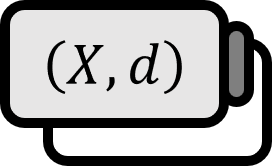Limit of Functions in Metric Spaces
Definition
Let $(X,d_{X})$, $(Y,d_{Y})$ be a metric space. Suppose $E\subset X$, $f: E\rightarrow Y$, and that $p$ is a limit point of $E$. Then, for every positive number $\varepsilon$,
$$ x \in E \ \text{and} \ d_{X}(x,p)<\delta \implies d_{Y}(f(x),q) <\varepsilon $$
exists $\delta>0$ such that,
$$ f(x)\rightarrow q\ \mathrm{as}\ x\to p $$
or
$$ \lim \limits_{x\to p}f(x)=q $$
is denoted and $f$ is said to have the limit $q$ at $p$.
Explanation
Now that we have learned the epsilon-delta argument, we can rigorously define the limit of a function in a metric space as above. It is important to note that by this definition, $p \in X$ need not be equal to $p \in E$. Hence, for some $p \in E$,
$$ f(p) \ne \lim \limits_{x\to p}f(x) $$
may hold.
Theorem
Assume $X$, $Y$, $E$, $f$, $p$ are as described in the definition. Then, the following two propositions are equivalent.
(a)
$$ \lim \limits_{x\to p}f(x) = q $$
(b)
For all sequences $E$ of $p_{n}\ne p$ that are $\lim \limits_{n\to\infty}p_{n}=p$,
$$ \lim \limits_{n\to\infty}f(p_{n})=q $$
Explained, $(b)$ means ‘for all sequences $\left\{ p_{n} \right\}$ converging to $p$, the sequence $\left\{ f(p_{n}) \right\}$ converges to $q$’.
Proof
(a) $\Longrightarrow$ (b)
Assume (a) holds. Choose any sequence $\left\{ p_{n} \right\}$ such that $\lim \limits_{n\to\infty} p_{n}=p$. Given any positive number $\varepsilon >0$, by assumption, there exists some positive number $\delta$ such that,
$$ \begin{equation} x \in E \quad \text{and} \quad d_{X}(x,p)<\delta \implies d_{Y}(f(x),q)<\varepsilon \label{eq1} \end{equation} $$
Also, since $\left\{ p_{n} \right\}$ is a sequence converging to $p$, there exists a positive number $N$ such that
$$ \begin{equation} n\ge N \implies d_{X}(p_{n},p) <\delta \label{eq2} \end{equation} $$
Therefore, by $\eqref{eq1}$ and $\eqref{eq2}$, the following holds.
$$ n\ge N \implies d_{X}(p_{n},p)<\delta \implies d_{Y}(f(p_{n}),q)<\varepsilon $$
This condition signifies that the sequence $\left\{ f(p_{n}) \right\}$ converges to $q$, thus
$$ \lim \limits_{n\to\infty} f(p_{n})=q $$
■
Before going into the proof, note that the following is slightly complicated. By contrapositive, if ‘(b) then (a)’ is true, it means that ‘if not (a) then not (b)’ is also true. So, we will show that ‘if $\lim \limits_{x\to p}f(x)=q$ does not hold, then for some sequence $\left\{ p_{n} \right\}$ converging to $p$, the sequence $\left\{ f(p_{n}) \right\}$ does not converge to $q$’.
(a) $\Longleftarrow$ (b)
Assume (a) does not hold. Then by definition, for some $\varepsilon$,
$$ \begin{equation} x\in E \quad \text{and} \quad d_{X}(x,p)<\delta \implies d_{Y}(f(x),q) \ge \varepsilon \label{eq3} \end{equation} $$
exists a positive number $\delta$. Consider any sequence $\left\{ p_{n} \right\}$ converging to $p$. Then,
$$ \begin{equation} n\ge N \implies d_{X}(p_{n},p) <\delta \label{eq4} \end{equation} $$
exists sufficiently large positive number $N$. Therefore, by $\eqref{eq3}$, $\eqref{eq4}$, for some $\varepsilon$,
$$ n \ge N \implies d_{X}(p_{n},p)<\delta \implies d_{Y}(f(p_{n}),q) \ge \varepsilon $$
does not hold, thus the sequence $\left\{ f(p_{n}) \right\}$ does not converge to $q$.
■
Corollary
If $f$ has a limit at $p$, that limit is unique.
This follows from properties of sequences converging in a metric space1 and the theorem above.
See (b) for reference. ↩︎
